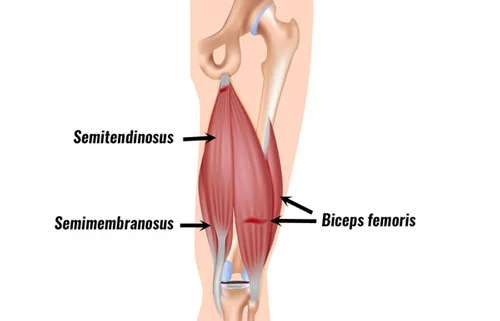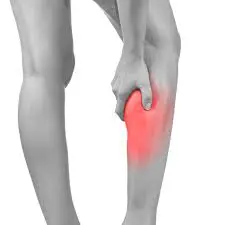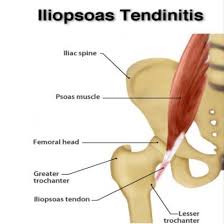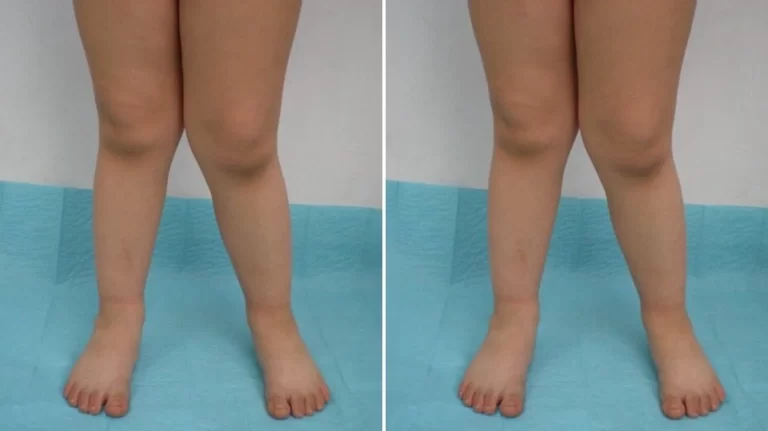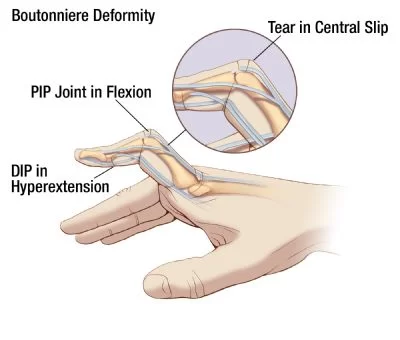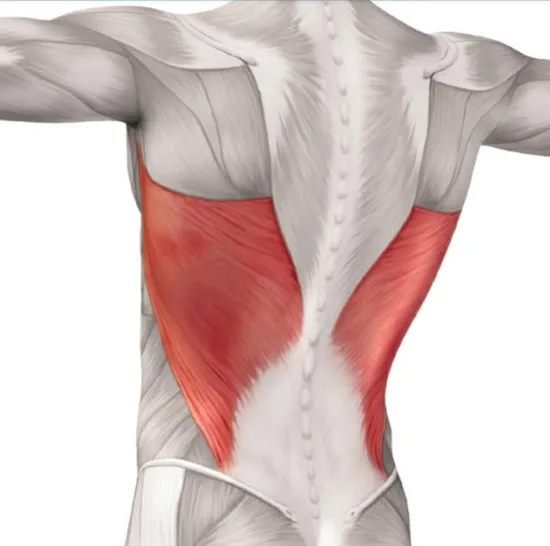Deltoid Muscle Pain
What is deltoid muscle pain?
Any pain which is felt on the rounded contour of the shoulder, be it front, back, or side, particularly while lifting the hand is typically called a deltoid pain. The pain might be dull, aching, or throbbing depending upon the mechanics which caused the pain.
Usually, the pain in the deltoid is intense while performing the deltoid muscle movements, such as doing overhead activities or just simply lifting the arm. In some cases, there might be swelling due to inflammation or bruising due to some mechanical injury. In case of severe pain followed by trauma or massive force load on the deltoid muscle, there might be intense pain caused by torn muscle fibers.
What is Deltoid Muscle?
The deltoid muscle is the round muscle that forms the top most layer or encloses the shoulder joint. It is responsible for giving the shoulder its characteristic rounded contour and plays a role in giving the shoulder increased freedom of movement.
As it is such an important muscle, it is very common for the deltoid muscle to be overused. And this overused is made known by the body in the form of pain.
Before discussing the reasons for pain in the deltoid muscle and how as an individual you can make a calculated approach towards it, first let us understand the basic anatomy of the muscle.
Where is Deltoid Muscle Located?
The deltoid muscle is a large rounded muscle, located at the uppermost part of the arm, at the rounded contour of the shoulder. The muscle is divided into three different parts or heads namely,
- anterior (front) fiber,
- middle fiber, and
- posterior (back) fiber.
The muscle originates from the outer aspect of your collarbone, precisely from the clavicle and from the outer aspects of the shoulder blades or acromion. It then moves forwards and laterally to get inserted in the funny bone or humerus. In other words, this enormous muscle connects your shoulder blades, collarbone, and arm altogether.
The reason it is important to understand the location of the deltoid muscle is to understand the course of your pain.
Let us now look into the various movements which get hindered due to the pain in the deltoid muscle.
What are the Functions of the Deltoid Muscle?
The deltoid is a very strong muscle and is needed for a variety of movements. The primary role of the deltoid is to aid in lifting and rotating the arm. Apart from this deltoid also acts as a shoulder stabilizer and prevents subluxation of the shoulder joint during overhead activities complying with rotation
A few examples of the movements where deltoid act as an agonist includes,
- For athletes, while playing throwing ball such as in cricket, volleyball, handball, rugby, while swimming, playing waterloo, netball, etc.,
- Examples from day-to-day activities include,
- playing catch
- combing and washing hairs
- wearing clothes
- drying oneself off
- in hygiene care practices
- carrying weights in hands like shopping bags, etc.
The deltoid muscle is innervated with the axillary nerve and is supplied from the posterior circumflex humeral artery.
Now that we have covered the basic anatomy, functions, and all such that about deltoid muscle, let us dive into our topic. What is deltoid muscle pain?
Test For Torn Deltoid
One of the tests that could be performed manually to check if the deltoid is torn or not is the Deltoid muscle tear test.
Ask the patient to gently lift or move their arms from the side up to the front while keeping them straight against slight resistance provided by a certified healthcare professional or with the use of dumbbells, sandbags, or resistance bands. An intense pain felt in this movement might be suggestive of torn deltoid. It is better to consult with a medical professional or an orthopedic surgeon in case of doubts.
What is the reason for deltoid muscle pain?
The pain over the deltoid muscle or the rear shoulder pain can be due to numerous reasons, the majority of all involving the overuse of the muscle. Depending upon the pathomechanics of the injury, the pain could be felt at
- back of the shoulder or posterior side,
- middle of the shoulder, and
- side of the shoulder, which might usually be felt side to side or sometimes might extend to different muscles.
The most common cause of deltoid pain is the strain or pulled muscle. This usually results from overuse injury. Other causes include,
- Trauma leading to torn deltoid fibers
- Deltoid tendonitis
- Frozen shoulder
- Shoulder bursitis
Let us look into all of them in detail.
Deltoid Strain
The deltoid strain can be caused by various reasons. The most common is overloading the muscle without any proper rest. The continuous overloading of the muscle without any warm-up can lead to various grades of strain. The most common way a person can strain the muscle include,
- sudden heavy loads on the muscle,
- repetitively performing a particular movement suddenly with no warm-up or rest in between,
- a sudden jerk to the muscle while carrying out heavy loads of eccentric contraction,
- performing sports after a prolonged gap period without an adequate warm-up session, or
- a trip or fall causing the entire body weight to be on the deltoid.
The population at the risk of deltoid strains includes,
- weight lifting both professionals and laborers
- swimmers
- skiers
- basketball players
- cricketers
- volleyball players
- baseball players
- painters
- teachers
- babysitters or pet sitters
- homemakers or house help
- in IT departments where the keyboard might be kept at an elevated height, such the shoulder flexion had to be included, etc
The strain of the deltoid muscle can be graded in different categories, which then lay a foundation for the management of the pain. Let us quickly look into the various grades for Deltoid strain,
Grade 1
- Results from when less than 10% of the muscle is involved.
- Is marked by slight tightness or soreness in the muscle.
- A person might feel mild discomfort while performing the movement such as lifting the hand but will be able to do so until the end range.
- For instance, the person might be able to do 3-5 repetitions of push-ups with slight discomfort in the area but not much so difficulty or pain.
- Might sometimes be accompanied by swelling.
Grade 2
- Results from when around 10-30% of the muscle is involved.
- Is marked by elevated pain, followed by swelling and limitation of muscle movement.
- With these, a person might not be able to use his arm properly and might feel excruciating pain while moving their arms in any direction.
- They are also referred to as partial tears of the muscle fibers.
Grade 3
- Results from when more than 30% of the muscle fiber is involved.
- Is marked by high amounts of pain accompanied by profound swelling, displaced muscle, palpable muscle tear, or gap.
- They are the severe form of the strains and often lead to a complete tear of muscle fibers.
- with these, the person is not able to even move their arms, let alone do any function with it.
- They usually result from heavy force or trauma and are accompanied by other injuries.
Next up we can look at other causes of deltoid pain.
Deltoid Tendonitis
Results from inflammation of the deltoid tendon, which is also due to overuse injuries or repeated movements.
Is commonly seen in patients with strenuous repetitive activities and athletes with either prolonged gap periods or no rest at all.
Shoulder Impingement
Usually found in swimmers, results when the deltoid is either inflamed or gets pinched in between the surrounding structures, causing pain and discomfort.
This is felt all over the shoulder including the deltoid.
Frozen Shoulder
- With no etiology known, frozen shoulder affects the shoulder joint as a whole.
- This leads to stiffness of the overall shoulder.
- Sometimes even when the movement is back, a person might feel pain in the deltoid region while performing the movements.
- It might be because, during the pathology when the rotator cuff muscles were weak, the deltoid overwork to compensate for them.
If Not Deltoid Muscle Pain, Then What?
The deltoid muscle connects the shoulder joint with the neck and the back. And because of this connection, any pain in the neck area or upper back might be speculated as deltoid pain. The shoulder joint itself is a complex interconnected structure with a lot of muscles, tendons, ligaments, bony parts, bursa, cartilage, vasculature nerves, and other soft tissues. Any kind of pathologies to any one of them might lead to or mimic deltoid pain. A few common examples include,
- rotator cuff pathologies
- SLAP lesions
- biceps tendonitis
- acromioclavicular joint (AC joint) dysfunction
- shoulder dislocation or subluxation
- shoulder fractures
- soft tissue injuries of related structures such as biceps
Most of the above-mentioned injuries are treated conservatively with rest, icing, and over-the-counter drugs. Some of them may require surgical intervention and are to be evaluated by a healthcare professional as soon as possible. The best way to differentiate if related to the deltoid or not, is clinicians might perform certain special tests or order diagnostic radiographs such as X-rays or MRI or CT scans if required.
Why does my Deltoid hurt after waking up Sleep?
Do you also wake up with one side of your shoulder feeling sorer than the night before? Or perhaps a bit of discomfort in moving a particular side shoulder after getting up ?t might be because you must have slept on your side at the night or accidentally have put a lot of pressure on that side of the shoulder while sleeping.
This might have happened because as we go into a deep sleep, the pressure on that particular area increases which might irritate already triggered or injured muscles. This is one of the prime reasons why, if you are undergoing any shoulder pathologies, the first thing the practitioner or the therapist advises is to not carry any weight on that particular side and to avoid side lying on the affected side.
Well but no one has control of their body while sleeping, especially if you prefer to sleep on that particular side in side lying. But there are a few tips that you can use to ensure that you don’t accidentally end up worsening your deltoid or shoulder pain.
- Try sleeping on your back.
- If not possible, keep pillows on either side of the shoulder point to provide the cushion needed to take off some of the pressure.
- If you prefer to sleep on another side, but tend to roll in your sleep, place under the shoulder such that the unaffected side is cushioned by it and your affected hand is resting on it inside lying.
- For example, if your left shoulder hurts and you tend to sleep on your right but might roll over at the night, keep a pillow under the right shoulder and lay on your right side on it. Now on the side lying rest your left hand on the pillow and place a pillow underneath the left side, so that even if you roll, the pillow will cushion or prevent the movement.
How To Ease The Deltoid Muscle Pain?
Now that we have seen what causes the deltoid pain, let us come to the section for what we came here. How do we ease that pain?
To treat any pain there are usually two methods, either the conservative method or the surgical method. In the conservative method, a health care practitioner uses medicines, rest, ice packs, and sometimes home remedies to reduce the pain. Usually, these methods could be done at home and don’t require hospitalization. The surgical method, as the name suggest involves surgical procedures, either invasive or non-invasive, with a minimum of 3 days of hospital stay.
It is very rare to use the surgical approach in case of Deltoid pain, unless and until associated with any trauma or act of violence. This usually includes muscle repair or fixing fractures. Let us look into various conservative methods in case of deltoid pain.
Conservative Methods
The conservative method which has been used for the past few decades is the PRICE protocol, i.e.,
- Protection
- Rest
- Icing
- Compression
- Elevation
To treat any form of soft tissue injuries, this is a widely used technique.
Protection means to protect the injured part from further movements. It is usually achieved by keeping the desired area in a protective covering such as a sling or shoulder brace. Sometimes a certified sports therapist might perform Kinesio-taping to keep the muscle in a protective stance.
Rest means to make sure you do not perform any more vigorous movements, sometimes preferably no movement at all. It is done to make sure the injured structures get adequate rest and are not aggravated more.
Icing means applying ice on the affected side. It is done because applying ice can cause the numbing effect which works as temporary local analgesia and decrease the pain intensity. Also, icing helps to decrease inflammation, which is the body’s primary response to any injury.
Compression means applying a compression bandage or crepe bandage over the injured site. This is done to prevent any blood loss from the macro or microvascular injury. And to also, ensure there isn’t too much swelling. Though swelling is a part of the body’s defense mechanism if gone overboard can hinder the healing process.
Elevate means to keep the injured part slightly above its natural anatomical state. This is done to decrease swelling. Since the lymphatic system has no clear-cut pumping system and thus relies on the body’s movement to travel. As we have hindered the movement already, elevation is done to help gravity aid in the flow of those lymph fluids to prevent any form of additional swelling.
Based on the grade of deltoid sprain, the conservative methods for treatment include,
Grade 1 Strain
- PRICE protocol with if needed mild pain killers.
- Icing is to be done periodically every 3-4 hours for 7-10 minutes for at least 24-48 hours.
- Keep the arm in a protective sling and minimize the use of the arm as much as possible.
- In about 2-3 days, when the swelling had subsided and the pain is decreased, try on some gentle stretches followed by Range of Motion exercises. This is to keep the muscle moving.
- After a day or two of this, move onto gradual isometric contraction, at first for 5-7 repetitions with a 3-5 second hold, and then gradually increase the reps or hold duration or both as per the plan or desired outcome.
- Gradually if needed, can progress into strength training by adding open chain exercises, mild resistance exercises, weight lifting, etc.
Grade 2 Strain
- PRICE protocol with over-the-counter anti-inflammatory and painkillers like ibuprofen or paracetamol.
- Icing is done religiously for 10-15 minutes every 2-3 hours for at least 3-4 days. Once the swelling has subsided, alternatively heat therapy or a contrast bath can be used to increase the healing process.
- Along with the protection sling, a compression bandage is also wrapped around the arm until the swelling subsides.
- After the initial pain and swelling are gone, ROM exercise is started. Usually, 7-10 repetition in a single set with 2-3 sets a day. The ROM is gradually increased with the joint venture of the patient and the physiotherapist.
- Once full ROM is achieved, then comes the strengthening and conditioning, which might take somewhere around a few weeks to months, depending upon the patient’s need. Here, a physiotherapist curates a tailored program specific to that particular patient’s needs, goals, and desired outcomes.
Grade 3 Strain
- PRICE protocol followed with some strong painkillers and anti-inflammatory.
- The affected arm is first put on a protective cast, such as a shoulder brace.
- Icing is done usually with the protection on for as long as and as often as needed for not more than 20 minutes in a single sitting.
- Once the protective period is done, the physiotherapist moves on to the rehabilitation part by first increasing the ROM with various manual techniques, followed by a strict period of strength training.
- Usually, the surrounding structures are also conditioned and this might take months before prior strength is achieved.
Role of Physiotherapy in Deltoid Muscle Pain
A Physiotherapist plays a huge role in easing and further preventing deltoid pain. By using electrotherapy and manual therapy, the therapist first works on reducing your pain. Once that is done, they curate a specially customized program for you based on your needs, desires, and goals.
For example, if a person who has grade 2 deltoid strain and their goal is to play catch with their kids, the physiotherapist might add strength training into their protocol which involves all the shoulder musculature like deltoid, rotator cuff, joint play, and sometimes even arm muscles like biceps and triceps.
Physiotherapists are also responsible for assessing and calibrating if a certain individual is ready for further advancement in training. For example, if a weight lifter wishes to upgrade their game, i.e. they want to lift a bit more weight than currently. Say he now lifts 200 pounds but now wishes to progress to 250. The therapist will first ensure if his muscles are capable of taking such a load by making sure they are in optimum condition. Then they will curate a plan accordingly, which involves conditioning the muscle to bear increased weight loads and enhance the strength of the muscle to ensure that no misshapen could take place.
Not only athletes but common people need a physiotherapist too. Suppose the pain you felt was because of an increased keyboard height while working. The therapist along with the occupational therapist can assess your workplace and give you a pointer to either create an alternative like using high chairs or reducing the height of the keyboard if possible.
A certified physiotherapist might also use advanced techniques like tapping, cupping, and dry needling to reduce the pain and enhance the healing mechanism. They might also advise ergonomic practices to ensure that proper posture is maintained and any unnecessary movement or jerky movements are avoided.
The usual Physiotherapy management for deltoid muscle pain includes,
- Pain relief from the use of electrotherapy such as TENS, Ultrasound, or sometimes LASER. The US and LASER also aid in enhancing the healing process and decreasing the swelling.
- After pain and swelling subside, next are ROM exercises. They are done to maintain or restore the deltoid muscle range. Usually involves moving the arm up, down, and sideways for 10-15 repetitions. The therapist makes sure that the movement is pain-free throughout the range.
- Once the range is restored, then comes the strengthening of the deltoid. It gradually starts with isometric contraction, moving to isotonic contraction followed by resistance exercises and weighted exercises, either bodyweight or with dumbbells or sandbags.
Exercises and Stretches
The physiotherapist uses a series of exercises and stretches to create a patient-centered rehabilitation plan. A few of them are explained below, which are easy to perform and are widely used.
1. Anterior Deltoid Stretch
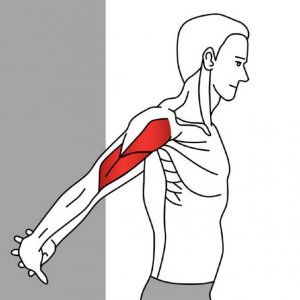
- Sit or stand straight with the shoulder relaxed and loose.
- Clasp your hands behind your backs as if standing in an attention pose. If you can’t clasp your hands, try holding the wrist of one hand with the other or a hand towel behind your back in two hands.
- Gently roll your shoulders, puff out the chest and squeeze shoulder blades together.
- Slowly pull your hands above, toward the ceiling to the point where you feel a minor stretch or a pleasant discomfort.
- Ensure that you are not leaning forward and are maintaining a straight posture while doing so.
- Relax your body as much as possible, breathe deeply through your nose and hold this position for 15-20 seconds.
- Repeat 3-5 times as per required.
2. Posterior Deltoid Stretch
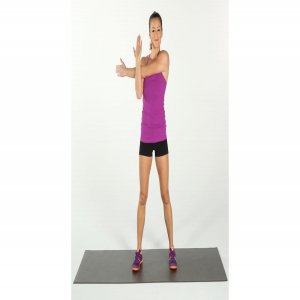
- Sit comfortably on a chair or stool. Alternatively, stand relaxed with feet a bit wider than hip-width.
- Relax your body and lift the arm to be stretched sideways as if passing a Frisbee to someone on your other side.
- Grasp the elbow of the outstretched hand with the other arm and gently pull the elbow in the same direction.
- Make sure you are only pulling your outstretched hand and not leaning towards the same side.
- Pull till you feel a slight deep stretch at the back of your shoulder.
- Maintain that for 15-20 seconds with a deep breath and relaxed body.
- Repeat 3-5 times.
3. Isometric Exercise
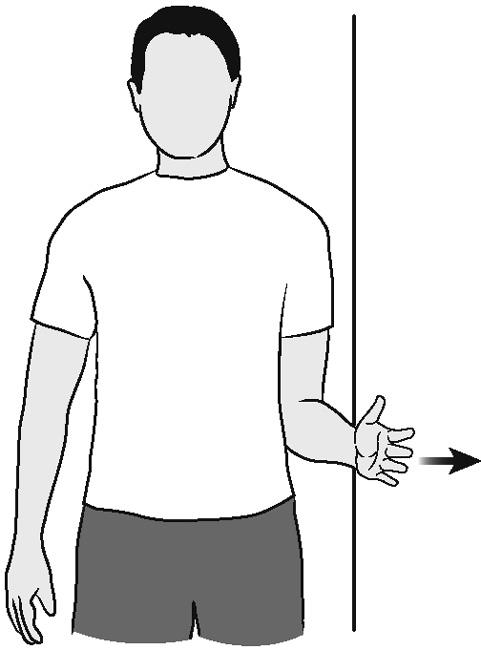
- To perform isometric deltoid exercise or static deltoid contraction, ask the patient o stand sideways with the side to be strengthened facing the wall and elbow flexed.
- Gently push the wall sideways.
- Make sure that the movement is pain-free.
- Hold the push for 5-7 seconds and slowly relax.
- Repeat for 10-12 repetitions.
- If pain is felt at any stage, stop the movement and confirm with your therapist whether you are ready for this movement or if you are performing it correctly.
4. Anterior Deltoid Raise
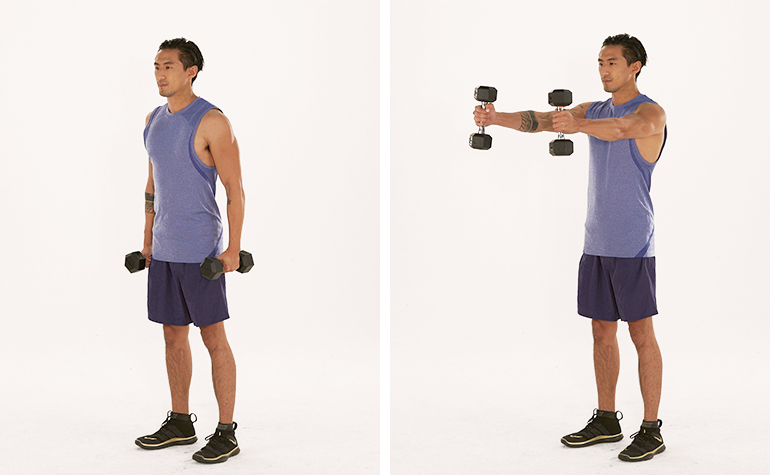
- To perform this weighted strengthening exercise you will need 1-2 dumbbells of equal weight. It is advisable to start with 0.5kgs to 1 kg and slowly increase the weight. Alternatively, you can use water bottles or tie-up sandbags on your wrist.
- This can be done either standing or sitting. If sitting, use a stool with no armrest and keep the back straight. If standing, stand with legs hip-width apart with knees unlocked and shoulder relaxed.
- Before performing the exercise, roll your shoulders clockwise and anticlockwise a couple of times to get them relaxed.
- Grasp the weights in one or both hands as per the instructions and lift the weights with palm facing down.
- Lift the arms only up to shoulder height.
- Breath in while lifting the weight and breath out while lowering them.
- You can either do 10-15 repetitions of them with no hold or 7-10 repetitions with a 3-5 second hold. This usually depends on whether your goal is to increase strength or build up endurance.
- Please note that the exercise should be pain-free and if the pain is felt stop the movement and consult with your physiotherapist.
- Alternatively, if the pain has increased post-exercise, it might be because you have overloaded the muscle before it is ready. Take rest for 2-3 days, perform gentle stretches and ROM exercises and start again when the pain subsides. This time with lesser weight.
5. Resistance Band Deltoid Exercise
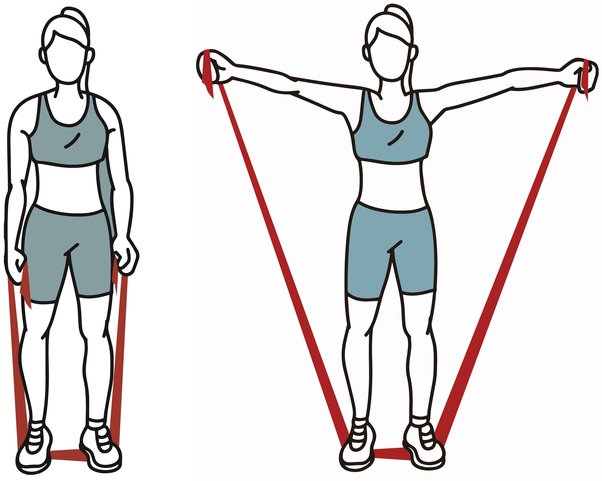
Sometimes resistance band exercises are used over the weighted exercise as they give the user a choice of how much resistance to bear.
The resistance band can be manipulated to perform a variety of deltoid exercises. A few of them include,
- Rear Deltoid Fly
- To perform this exercise, hold both ends of the theraband in your hand and place the middle of the resistance band underneath the feet as shown in the figure above.
- Once the resistance band is secured, gently lift your arms sideways up to shoulder height.
- You can either hold the position for 3-5 seconds or lower it immediately.
- At first, a repetition of 7-10 is good enough.
- Please note you should not be feeling any pain throughout the movement.
- Perform gentle calculated sideways hand raises with as smooth a movement as possible.
- Alternatively, you can either perform the movement with both hands together or one after the other. In case of later, another hand is loosely left hanging on the side.
- Front Deltoid Raise
- This is similar to the anterior deltoid raise.
- To perform the movement, hold the resistance band’s edge in one hand and secure the other either underneath the foot or on one sturdy surface which is below your knee height, like the leg of the bed.
- Gently raise the arm in front of you with the palm facing down, to the height of the shoulder.
- Either hold the position or lower it immediately.
- The movement should be pain-free and smooth.
- You can start off with 10-15 repetitions.
- Please note to keep the knees and elbow unlocked or soft to avoid any unnecessary strain on the joints.
Recovery
Now that we have discussed various techniques and exercises to help ease the pain, the next question that comes to mind is, for how long? For how long are we supposed to carry this particular maneuver or stop our activities? When can we return back to normal?
The answer to your question is – It all depends on what type of injury you have and how good of care you have taken. For example, a person with Grade 1 strain can return to normal in a maximum of 5-7 days. They just have to wait till the pain is resolved and then move on to the general stretches and gradual progressive strengthening exercises. But if they or the healthcare professional calculated wrong and overloaded the muscle, the injury might resurface or worse get more severe. It is therefore advisable to not take any drastic decisions and to check in with your therapist soon enough if the pain or swelling has increased following a session.
In general, it might take,
- 7-10 days for Grade 1 Strain
- 10-15 days for Grade 2 Strain
- Somewhere around a month or less for Grade 3 Strain
Sometimes a certified sports therapist or physiotherapist might advise you to take longer periods of rest if they feel that your body is not ready yet for the workload.
Precautions to be taken during the Pain
While the above-mentioned methods can help reduce the pain, certain precautions could be taken by an individual to ensure limited or pain-free movements and no repeat of the same.
- A proper warm-up and cool down before and after any strenuous activities respectively. Warm-up help prepares the muscle for increased overload and cool-down helps to reduce the post soreness by relaxing the muscle. For deltoid, warm-up could be a few stretches followed by 10-15 repetitions of the particular movement involved. And cool-down might be sustained stretches followed by an ice pack if required.
- If you have a newly started exercise regime, it is good to divide it into different muscle groups as this gives time for the muscle to rest and heal without overloading them too much.
- If you want to up your exercise regime it is better to consult with a fitness trainer or a physiotherapist to check if your deltoid is strong enough to bear the load. Slow and steady is the trick to avoiding any unwanted injuries to hinder gym time.
- Strengthening the surrounding structures is also very important as they support the muscle being stimulated. Here, strengthening your rotator cuffs and arm muscle is equally important to aid deltoid.
- Maintaining your posture and using ergonomically friendly desks or tables while sitting for a prolonged period is very important. And so is to take periodic rests and give the muscle required stretch and rest.
- If your work is demanding and requires heavy man work, it is advisable to practice a strengthening regime 3-4 times a week to condition the muscles properly and avoid any injuries.
- Hitting a spa or massage therapist’s office every once a month is not too bad of an option to help relax those tight musculatures and ease in pain. But do remember to practice a stretching regime religiously to maintain that loosening and flexibility.
Red flags to Seek a Specialist
Soft tissue pain is usually treated with rest, ice, and over-the-counter medications for pain and swelling. But if a person has,
- no visible improvement in pain or swelling for over 10 days
- is unable to even lift their arm with or without support
- are not being able to sleep due to pain
- have a history of trauma or violence preceding the pain
- have discoloration of the skin or blackening of the skin
- has less or no sensation in the area compared to the unaffected side
- feels tingling or numbness in the area
- has any other associated injuries
- is in extremes of age
- is osteoporotic or has any known history or family history of muscular dystrophies or any other genetic conditions,
It is advisable to consult with a doctor or certified healthcare professional. Always, in case of any kind of doubts, it is better to check in with a medical practitioner than to make assumptions and regret it later on.


